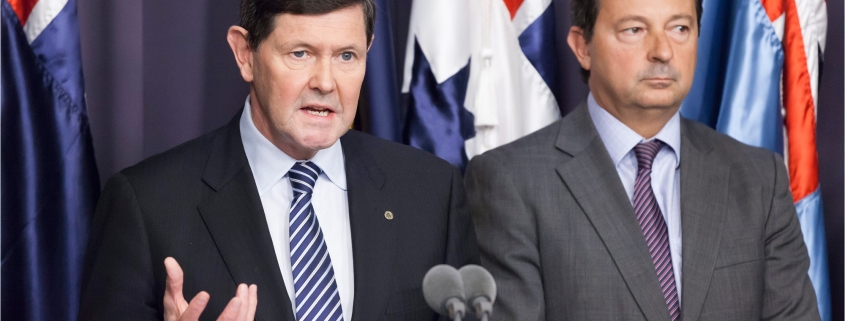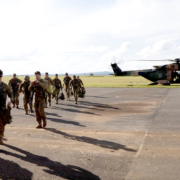Looking back to look forward, 10 years after the First Principles Review
Exactly 10 years ago, the then minister for defence, Kevin Andrews, released the First Principles Review: Creating One Defence (FPR). With increasing talk about the rising possibility of major power-conflict, calls for Defence funding to increase to at least 3 percent of GDP, and questions raised about Defence’s ability to spend the money appropriated to it, it is the perfect time to assess whether Defence created the sustainable and enduring business model that the Review championed.
The FPR was commissioned in August 2014 by the predecessor of Andrews, David Johnston, as both an election commitment and a response to the 2014 National Commission of Audit’s recommendation for an efficiency review ‘as a pre-condition for setting any new funding profile for Defence under the White Paper’.
Conducted over eight months and chaired by David Peever, the FPR was an end-to-end review of Defence’s business processes, structure and organisation. It was designed to look forward to the challenges Defence would face in the 21st century and structured around the need for a sustainable and enduring business model. The combined effect of the review was supposed to be a more unified and integrated organisation, more consistently linked to strategy and led by its centre.
Key among the FPR’s recommendations were:
—Establishment of a strong, strategic centre to strengthen accountability and top-level decision-making. This would involve a new ‘One Defence’ business model, a streamlined top level management structure, establishment of a strong and credible internal contestability function, and a reduced number of committees;
—The establishment of a single end-to-end capability development function to maximise the efficient, effective and professional delivery of military capability. This included establishing the new Capability Acquisition and Sustainment Group (CASG) with reduced management layers, and transferring accountability for requirements setting and management to the vice chief and the service chiefs;
—The implementation of an enterprise approach to the delivery of services enabling corporate and military operations to maximise their effectiveness and efficiency. This would involve consolidation and standardisation in estate, information management, geospatial intelligence and customer-centric service delivery;
—The creation of a ‘One Defence’ workforce to ensure committed people with the right skills are in appropriate jobs, through the development of a strategic workforce plan for building a highly professional workforce across the Department and the Australian Defence Force; and
—The management of staff resources to deliver optimal use of funds and maximise efficiencies, through stripping back and simplification of overly complicated processes and structures, as well as the introduction of greater transparency, contestability and professionalism.
The review set out an ambitious agenda to ensure that Defence was fit for purpose and able to deliver with the minimum resources necessary. Most of the recommendations were implemented over two years.
At its simplest, the FPR sought to ensure that respective ministers, secretaries and chiefs of defence force would ask themselves every working day: Does this decision (or these options to government) strip back and simplify complicated processes and structures? Do they introduce greater transparency, contestability and professionalism? Do they enforce accountability and leadership?
Against these three questions, sadly, Defence’s implementation did not climb to the ambitions demanded by the review team. Despite the FPR’s intent to dethatch Defence’s hierarchy, devolve accountabilities to the lowest level possible and de-layer the organisation, Defence now has more senior executive service and star-ranked officers and organisational units than it did in 2015.
Committee structures have similarly reverted, though it should be acknowledged that the Investment Committee has been a positive advance for the organisation, though the burden on its members continues to be back-breakingly cumbersome. The behavioural change that is necessary to transform Defence seems to have broken on the rocks of institutional resistance.
The review highlighted ‘an organisational culture within Defence that is risk-averse and resistant to change’. The FPR authors were deeply focused on the risk culture of the organisation and many of their recommendations centred on practical ways to overcome this risk aversion. The simplicity and elegance of their recommendations were certainly lost on the upper floors of the Russell offices during the implementation process.
Defence’s failure to change—with concomitant failure to deliver—represents the organisation’s unwillingness to explore a different concept of risk management. This was also the case with Peever’s subsequent review of Defence innovation in 2021, which called for Defence to embrace a desire to improve (we think—the review was heavily redacted, including all of its recommendations).
Similarly, the concept of a single end-to-end capability development function has not taken root, with the contestability function failing to meet the aim of a ‘robust and disciplined contestability function to provide arm’s-length assurance to the secretary that the capability needs and requirements are aligned with strategy and resources and can be delivered’. Correspondingly, the transfer of accountability to the service chiefs appears to have frustrated the FPR’s aims for an integrated capability management process, in which all the fundamental inputs to capability (including industry support, facilities, ICT and workforce) are managed as a whole.
This has been particularly challenging for the capability managers within CASG, who no longer have all the levers necessary to effectively and efficiently manage the ‘smart buyer’ function. It appears that the common-sense approach to acquiring and sustaining capability—where the full process does not need to be followed when common sense says that the judicious use of a fast-track path is appropriate and risks are acceptable—has struggled. Few are the examples of innovative use of procurement practices, development of fast-track projects, or the creation of novel contractual relationships.
Skill development in CASG, and in Defence more broadly, continues to be a fundamental challenge. The Defence Workforce Plan didn’t emerge until 2024, and we are yet to see whether this plan will effectively deliver the required workforce, identify the critical skills gaps or build those skills and workforce strategies that place ‘the right people with the right skills in the right roles at the right time to deliver Defence’s mission’.
Defence is pursuing yet another strategic reform agenda, set out in Chapter 11 of the National Defence Strategy. It aims to deliver both strategic reform—the transformation of the core elements of Defence that deliver effects to achieve the strategy of denial—and enterprise reform—the transformation of Defence’s enabling elements that drive performance. In doing so, it could do worse than returning to the fundamental first principles that drove the FPR:
—Clear authorities and accountabilities that align with resources (empowering decision-makers to deliver on strategies and plans within agreed resourcing, while also holding them responsible);
—Outcome orientation (delivering what is required with processes, systems and tools being the means, not the end);
—Simplicity (eliminating complicated and unnecessary structures, processes, systems and tools);
—Focus on core business (Defence doing only for itself what no one else can do more effectively and efficiently);
—Professionalism (encouraging committed people with the right skills in appropriate jobs);
—Timely, contestable advice (using internal and external expertise to provide the best advice so that the outcome is delivered in the most cost-effective and efficient manner); and
—Transparency (behaving in a way that enables others to know exactly what Defence is doing and why).
If Australia is to effectively meet the challenges it faces, the government and the public need to have confidence in the combat capabilities of its armed forces, the effectiveness and timeliness of Defence’s decision making and the efficient use of the nation’s treasure.
Peever and his team set up a strong and sensible plan to ensure Defence was able to meet these three demands. Sadly, because of culture, behaviour and bureaucratic malaise, the FPR proved less enduring than the review team—and the Australian public—needed it to be.



